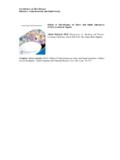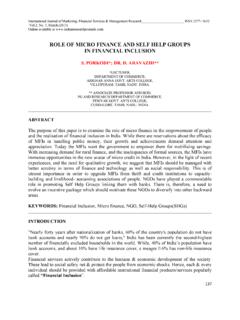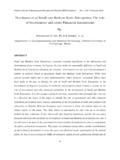Transcription of WOMEN EMPOWERMENT- ROLE OF MICRO FINANCE
1 IOSR Journal of Economics and FINANCE (IOSR-JEF) e-ISSN: 2321-5933, p-ISSN: 2321-5925 PP 69-76 International Conference on Innovative Management Strategies 69 | Page Madanapalle Institute of Technology & Science, Bangalore, INDIA WOMEN EMPOWERMENT- ROLE OF MICRO FINANCE (An Empirical study conducted in Madanapalle rural area SHG s) Associate Professor, Department of Management Studies, Madanapalle Institute of Technology & Science, MADANAPALLE-517325, Andhra Pradesh, India. ABSTRACT: Microfinance is a banking activity which provides financial assistance/loans to unemployed or individuals and groups as a whole. MICRO FINANCE through Self Help Group (SHG) is a powerful and suitable way of reaching financial assistance to the people directly for rural development. Empowerment of WOMEN is the main aim of microfinance, which leads to sustainable development of the nation.
2 In this paper, the role of Microfinance in WOMEN s empowerment is considered. For this study the following objectives have been framed. 1. To study the functioning of SHGs in Madanapalle Mandal area 2. To know the freedom of the WOMEN that they enjoy in SHG 3. To study the problems of WOMEN members of SHG 4. To analyze the WOMEN empowerment psychologically, sociologically and economically and 5. To offer suggestions for the betterment of WOMEN s empowerment. The study is undertaken in rural areas of Madanapalle Mandal. For this study both primary and secondary data is used. Primary data is collected from the respondents through a questionnaire and secondary data is collected from published reports, government publications and reports and other documents, discussions with NGOs and their reports and other documents. The researcher used various statistical tools which required for better analysis and interpretation.
3 Keywords: Microfinance, WOMEN empowerment, Self Help groups, Non Governmental Organization. I. INTRODUCTION A majority of microfinance programs target WOMEN with the explicit goal of empowering them. There are varying underlying motivations for pursuing WOMEN empowerment. Some argue that WOMEN are amongst the poorest and the most vulnerable of the underprivileged and thus helping them should be a priority. Whereas, other believe that investing in WOMEN s capabilities empowers them to make choices which is a valuable goal in itself but it also contributes to greater economic growth and development. The size of 20 has been made mandatory because any group larger than this has to be registered under the Indian Societies Registration Act. Self-help groups intermediated by MICRO credit have been shown to have positive effects on WOMEN , with some of these impacts being ripple effects.
4 They have played valuable roles in reducing the vulnerability of the poor, through asset creation, income and consumption smoothing, provision of emergency assistance, and empowering and emboldening WOMEN by giving them control over assets and increased self-esteem and knowledge (Zaman 2001). Several recent assessment studies have also generally reported positive impacts (Simanowitz and Walker 2002). In India, for example, microfinance is typically defined as the provision of thrift, credit and other financial services and products of very small amounts to the poor in rural, semi-urban or urban areas for enabling them to raise their income levels and improve living standards (NABARD, 2004). In addition to promoting the establishment or growth of MICRO enterprises, microfinance can increase the standard of living of the economically active poor, improve their access to health care and education, reduce vulnerability and promote the empowerment of WOMEN and marginalized groups.
5 In India, MICRO credit studies done on groups dealing with dairy farming have noted positive profit levels and short payback periods for loans (Lalitha and Nagarajan 2002). Earnings generated from such undertakings have been instrumental in increasing the physical well-being of the household, often through better nutrition and sanitation. The household's asset base has also been enhanced by the addition of jewellery (a portable asset), improved housing and land purchase in some cases. IOSR Journal of Economics and FINANCE (IOSR-JEF) e-ISSN: 2321-5933, p-ISSN: 2321-5925 PP 69-76 International Conference on Innovative Management Strategies 70 | Page Madanapalle Institute of Technology & Science, Bangalore, INDIA II. REVIEW OF LITERATURE Bennett (2002) has developed a framework in which "empowerment" and "social inclusion" are closely related but separate concepts.
6 Drawing on Narayan (2002), Bennett describes 14 empowerment as "the enhancement of assets and capabilities of diverse individuals and groups to engage, influence and hold accountable the institutions which affect them." Social inclusion is defined as "the removal of institutional barriers and the enhancement of incentives to increase the access of diverse individuals and groups to assets and development opportunities." According to World Bank, empowerment is the process of increasing the capacity of individuals or groups to make choices and to transform those choices into desired actions and outcomes . According to Krishna (2003) empowerment means increasing the capacity of individuals or groups to make effective development and life choices and to transform these choices into desired actions and outcomes. It is by nature a process and/or outcome.
7 Microfinance and WOMEN Empowerment: A majority of microfinance programs target WOMEN with the explicit goal of empowering them. There are varying underlying motivations for pursuing WOMEN empowerment. Some argue that WOMEN are amongst the poorest and the most vulnerable of the underprivileged and thus helping them should be a priority. Whereas, other believe that investing in WOMEN s capabilities empowers them to make choices which is a valuable goal in itself but it also contributes to greater economic growth and development. It has been well-documented that an increase in WOMEN s resources results in the well-being of the family, especially children (Mayoux, 1997; Kabeer, 2001; Hulme and Mosley, 1997). A more feminist point of view stresses that an increased access to financial services represent a penning/opportunity for greater empowerment.
8 Such organizations explicitly perceive microfinance as a tool in the fight for the WOMEN s rights and independence. Finally, keeping up with the objective of financial viability, an increasing number of microfinance institutions prefer WOMEN members as they believe that they are better and more reliable borrowers. III. STATEMENT OF THE PROBLEM In olden days WOMEN were restricted to take part in any social activities and not given roles in decision making in her family. The situation was even more worsening in rural and remote areas. Now the situation has been changed. She is given freedom to do what she wishes. In today s scenario more WOMEN are engaged in income generating activities. This is because of NGO and other financial institution came forward to provide microfinance to poor WOMEN . They believe that a woman is the small credit risk and often benefits the whole family.
9 The main aim of microfinance is to empower WOMEN . This induced the researcher to focus more on the empowerment of rural WOMEN who participates in the microfinance. 4. OBJECTIVES OF THE STUDY 1. To study the functioning of SHGs in Madanapalle Mandal area. 2. To know the freedom of the WOMEN that they enjoy in SHG. 3. To study the problems of WOMEN members of SHG. 4. To analyze the WOMEN empowerment psychologically, sociologically and economically. 5. To offer suggestions for the betterment of WOMEN empowerment. 5. Research Methodology Sources of Data: The study is conducted in Madanapalle rural areas of Chittoor district of Andhra Pradesh. For this study, primary data, which is enumerated from a field survey in the study area, is used. Secondary data, which is collected from different sources like concerned authorities and officials, NGO reports. Six Self-Help Groups in rural areas of Madanapalle mandal are taken for study.
10 The following are the areas selected for conducting the study. 1. Kotha Palle 2. Ramacharla Palle 3. Chippili 4. Vempalle 5. Valasa Palle 6. Kotavari Palle IOSR Journal of Economics and FINANCE (IOSR-JEF) e-ISSN: 2321-5933, p-ISSN: 2321-5925 PP 69-76 International Conference on Innovative Management Strategies 71 | Page Madanapalle Institute of Technology & Science, Bangalore, INDIA Sampling Method: For this study, both cluster and area sampling methods are employed. As number of members is more, they are divided into groups and selected randomly for collection of data. Sample Size: The size of the sample is 180 and data is collected from all the six rural villages of Madanapalle Mandal. Tools for analysis of data: For analysis and interpretation of data, tools of Simple correlation coefficient, paired t-test, cross tabulation and percentages have been applied.
















